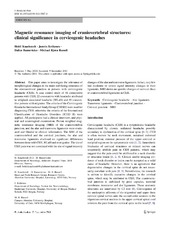Magnetic resonance imaging of craniovertebral structures: clinical significance in cervicogenic headaches
Peer reviewed, Journal article
Published version
Permanent lenke
https://hdl.handle.net/1956/5449Utgivelsesdato
2011-09-27Metadata
Vis full innførselSamlinger
Originalversjon
https://doi.org/10.1007/s10194-011-0387-4Sammendrag
This paper aims to investigate the relevance of morphological changes in the main stabilizing structures of the craniocervical junction in persons with cervicogenic headache (CEH). A case control study of 46 consecutive persons with CEH, 22 consecutive with headache attributed to whiplash associated headache (WLaH) and 19 consecutive persons with migraine. The criteria of the Cervicogenic Headache International Study Group (CHISG) were used for diagnosing CEH; otherwise the criteria of the International Classification of Headache Disorders (ICHD II) were applied. All participants had a clinical interview, and physical and neurological examination. Proton weighted magnetic resonance imaging (MRI) of the craniovertebral junction, and the alar and transverse ligaments were evaluated and blinded to clinical information. The MRI of the craniovertebral and the cervical junctions, the alar and transverse ligaments disclosed no significant differences between those with CEH, WLaH and or migraine. The site of CEH pain was not correlated with the site of signal intensity changes of the alar and transverse ligaments. In fact, very few had moderate or severe signal intensity changes in their ligaments. MRI shows no specific changes of cervical discs or craniovertebral ligaments in CEH.

